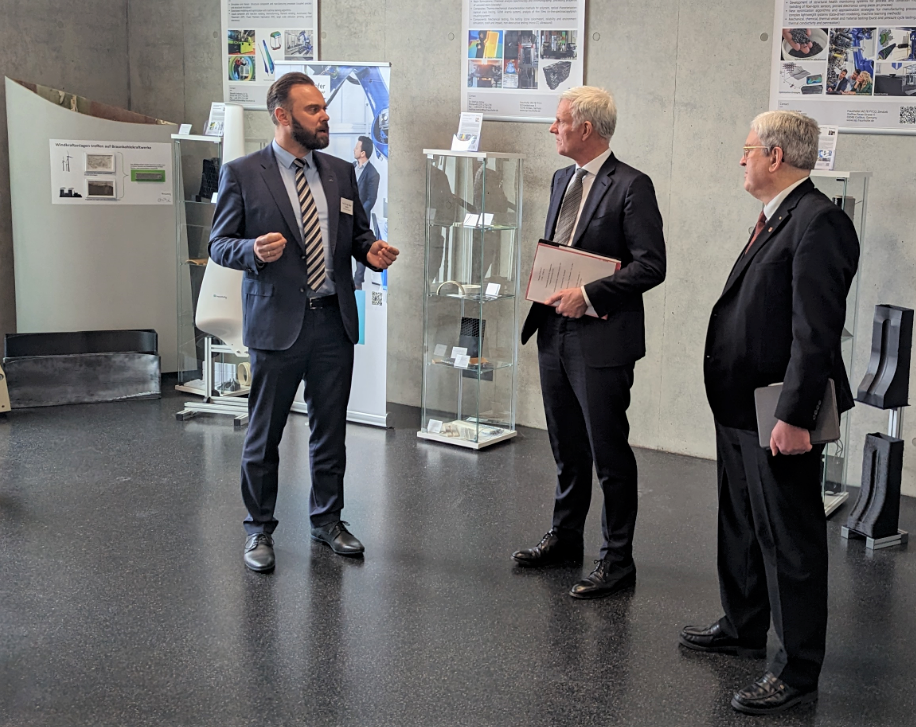Steinbach and Schwarz launch lightweight construction initiative
Lightweight construction increasingly important for the future viability of the Berlin-Brandenburg industrial location – federal states bundle competences.

Wildau. Today, the economic departments of Berlin and Brandenburg launched the joint lightweight construction initiative of both federal states. The Brandenburg Minister of Economics Prof. Dr.-Ing. Jörg Steinbach and the Berlin Senator for Economics Stephan Schwarz emphasized at the event at Fraunhofer Institute for Applied Polymer Research IAP at the Wildau location the increasing relevance of lightweight construction for the future viability of the Berlin-Brandenburg industrial location. "It is about more visibility for the companies already active in lightweight construction in the capital region. And it is about bundling our competences," Steinbach and Schwarz emphasized.
Minister Steinbach said, "Lightweight construction stands for new technologies and products, innovative materials and processes. The joint lightweight construction initiative is another step towards a sustainable and future-proof economy in the capital region. In addition, lightweight construction creates new jobs and added value in Brandenburg and Berlin."
Senator Schwarz added, "The future belongs to lightweight construction and with our initiative we want to ensure that this future is written in Berlin and Brandenburg. To do this, we want to develop our innovative and creative environment together and create favorable conditions for investments, future-proof value chains, and thus also for new jobs."
Professor Holger Seidlitz, Head of the Research Division “Polymer Materials and Composites PYCO” at Fraunhofer IAP and host of the event, said, "The challenge here is to understand and master the complex interrelationships that arise in the development of highly integrated lightweight construction systems in multi-material construction in conjunction with the associated manufacturing processes along the entire product life cycle."
For the energy transition and the necessary achievement of climate goals, lightweight construction is an essential component and cross-sectoral key technology. Above all, it allows to reduce manufacturing and operating costs by using lighter materials. Lightweight construction is of particular interest for the mobility of the future, construction, mechanical and plant engineering, energy or medical technology. These industries with high value-added potential play an important role for the economy in the capital region.
By promoting lightweight construction technologies, companies are enabled to develop high-performance and at the same time environmentally friendly products, reduce CO2 emissions and costs, increase their competitiveness and create new industrial jobs. The new initiative offers the opportunity to support young companies and start-ups so that they can bring their innovative ideas and products to the market faster and thus make the capital region an attractive lightweight construction location.
For information:
According to the Federal Ministry of Economics, about 43 percent of the costs in the manufacturing industry in 2021 were accounted for lightweight materials. Already 22 percent of small and medium-sized enterprises used lightweight materials. Systemic lightweight construction is also a driver for resource- and energy-efficient products through the combination of different materials in connection with sustainable material cycles.
Since both materials and construction, joining and manufacturing processes are constantly being developed, components and systems with improved properties are continuously being created. In combination with digitization, intelligent lightweight construction opens up new future markets in many economic sectors. Further optimization potential can be expected through the integration of extended functions as well as load- and material-appropriate design. Weight, raw materials and resources that can be saved in the product consume less energy both during production and during the life cycle, thus leading to an immediate reduction in CO2 emissions. Lightweight construction technologies thus directly address important economic and social sustainability goals.
Last modified: